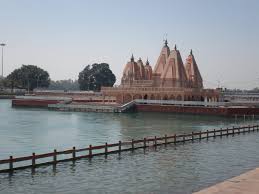Vaishno Devi

Vaishno Devi Vaishno Devi, also known as Mata Rani, Trikuta and Vaishnavi , is a manifestation of the Hindu Mother Goddess Mahalakshmi . The words "maa" and "mata" are commonly used in India for " mother ", and thus are often used in connection with Vaishno Devi. Vaishno Devi Mandir ( Hindi : वैष्णोदेवी मन्दिर ) is a Hindu temple dedicated to the Hindu Goddess, located in Katra at the Trikuta Mountains within the Indian state of Jammu and Kashmir . The Temple or Bhawan is 13.5 km from Katra and various modes of transportation are available from katra to Bhawan, including Ponies, Electric vehicles and paalkhis operated by 2 or 4 persons. Helicopter services are also available up to Sanjichhat, which is 9.5 km from Katra. [1] Bhairon temple is another 1.5 km from Bhawan.












